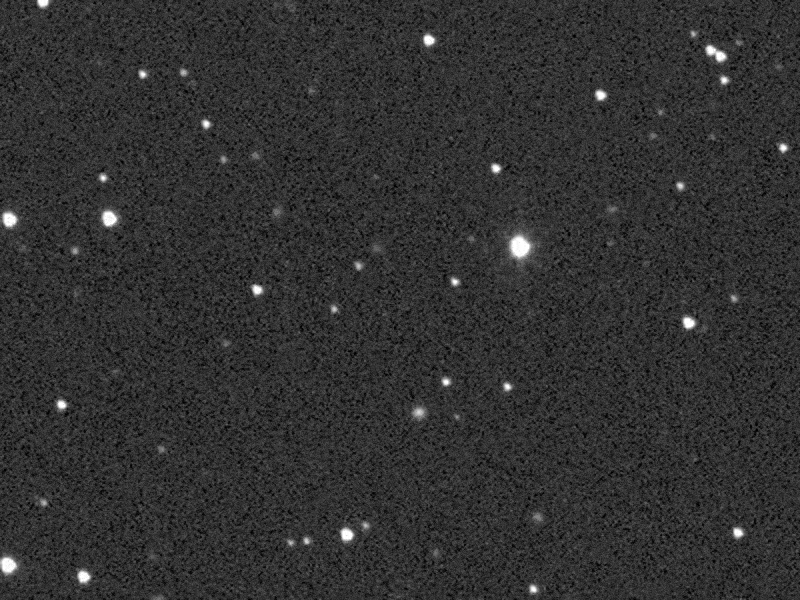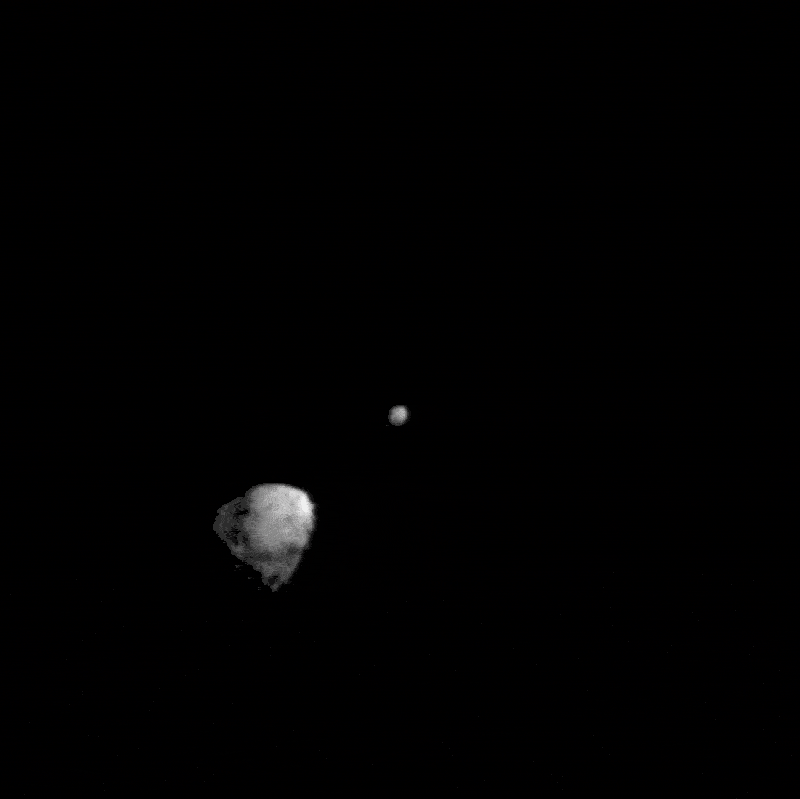NASA confirmed Monday that the DART mission was a success, but it may take up to several weeks to monitor for changes in the asteroid's trajectory. The goal was to shave several minutes off Dimorphos' nearly 12-hour orbit around Didymos.
27.09.2022
NASA’s DART Mission Hits Asteroid in First-Ever Planetary Defense Test

After 10 months flying in space, NASA’s Double Asteroid Redirection Test (DART) – the world’s first planetary defense technology demonstration – successfully impacted its asteroid target on Monday, the agency’s first attempt to move an asteroid in space.
Mission control at the Johns Hopkins Applied Physics Laboratory (APL) in Laurel, Maryland, announced the successful impact at 7:14 p.m. EDT.
As a part of NASA’s overall planetary defense strategy, DART’s impact with the asteroid Dimorphos demonstrates a viable mitigation technique for protecting the planet from an Earth-bound asteroid or comet, if one were discovered.
“At its core, DART represents an unprecedented success for planetary defense, but it is also a mission of unity with a real benefit for all humanity,” said NASA Administrator Bill Nelson. “As NASA studies the cosmos and our home planet, we’re also working to protect that home, and this international collaboration turned science fiction into science fact, demonstrating one way to protect Earth.”
DART targeted the asteroid moonlet Dimorphos, a small body just 530 feet (160 meters) in diameter. It orbits a larger, 2,560-foot (780-meter) asteroid called Didymos. Neither asteroid poses a threat to Earth.
The mission’s one-way trip confirmed NASA can successfully navigate a spacecraft to intentionally collide with an asteroid to deflect it, a technique known as kinetic impact.
The investigation team will now observe Dimorphos using ground-based telescopes to confirm that DART’s impact altered the asteroid’s orbit around Didymos. Researchers expect the impact to shorten Dimorphos’ orbit by about 1%, or roughly 10 minutes; precisely measuring how much the asteroid was deflected is one of the primary purposes of the full-scale test.
“Planetary Defense is a globally unifying effort that affects everyone living on Earth,” said Thomas Zurbuchen, associate administrator for the Science Mission Directorate at NASA Headquarters in Washington. “Now we know we can aim a spacecraft with the precision needed to impact even a small body in space. Just a small change in its speed is all we need to make a significant difference in the path an asteroid travels.”
The spacecraft’s sole instrument, the Didymos Reconnaissance and Asteroid Camera for Optical navigation (DRACO), together with a sophisticated guidance, navigation and control system that works in tandem with Small-body Maneuvering Autonomous Real Time Navigation (SMART Nav) algorithms, enabled DART to identify and distinguish between the two asteroids, targeting the smaller body.
These systems guided the 1,260-pound (570-kilogram) box-shaped spacecraft through the final 56,000 miles (90,000 kilometers) of space into Dimorphos, intentionally crashing into it at roughly 14,000 miles (22,530 kilometers) per hour to slightly slow the asteroid’s orbital speed. DRACO’s final images, obtained by the spacecraft seconds before impact, revealed the surface of Dimorphos in close-up detail.
Fifteen days before impact, DART’s CubeSat companion Light Italian CubeSat for Imaging of Asteroids (LICIACube), provided by the Italian Space Agency, deployed from the spacecraft to capture images of DART’s impact and of the asteroid’s resulting cloud of ejected matter. In tandem with the images returned by DRACO, LICIACube’s images are intended to provide a view of the collision’s effects to help researchers better characterize the effectiveness of kinetic impact in deflecting an asteroid. Because LICIACube doesn’t carry a large antenna, images will be downlinked to Earth one by one in the coming weeks.
“DART’s success provides a significant addition to the essential toolbox we must have to protect Earth from a devastating impact by an asteroid,” said Lindley Johnson, NASA’s Planetary Defense Officer. “This demonstrates we are no longer powerless to prevent this type of natural disaster. Coupled with enhanced capabilities to accelerate finding the remaining hazardous asteroid population by our next Planetary Defense mission, the Near-Earth Object (NEO) Surveyor, a DART successor could provide what we need to save the day.”
With the asteroid pair within 7 million miles (11 million kilometers) of Earth, a global team is using dozens of telescopes stationed around the world and in space to observe the asteroid system. Over the coming weeks, they will characterize the ejecta produced and precisely measure Dimorphos’ orbital change to determine how effectively DART deflected the asteroid. The results will help validate and improve scientific computer models critical to predicting the effectiveness of this technique as a reliable method for asteroid deflection.
“This first-of-its-kind mission required incredible preparation and precision, and the team exceeded expectations on all counts,” said APL Director Ralph Semmel. “Beyond the truly exciting success of the technology demonstration, capabilities based on DART could one day be used to change the course of an asteroid to protect our planet and preserve life on Earth as we know it.”
Roughly four years from now, the European Space Agency’s Hera project will conduct detailed surveys of both Dimorphos and Didymos, with a particular focus on the crater left by DART’s collision and a precise measurement of Dimorphos’ mass.

Johns Hopkins APL manages the DART mission for NASA's Planetary Defense Coordination Office as a project of the agency's Planetary Missions Program Office.
Quelle: NASA
+++
NASA spacecraft successfully collides with asteroid
Mission tested devices that could stop a future asteroid impact with Earth.
NASA has successfully tested its Double Asteroid Redirection Test spacecraft, or DART, which collided with an asteroid Monday night.
Asteroid Dimorphos, which NASA said is the size of a football stadium, does not pose a threat to the planet, in this case. But the mission will help scientists test technologies that could prevent a potentially catastrophic asteroid impact.
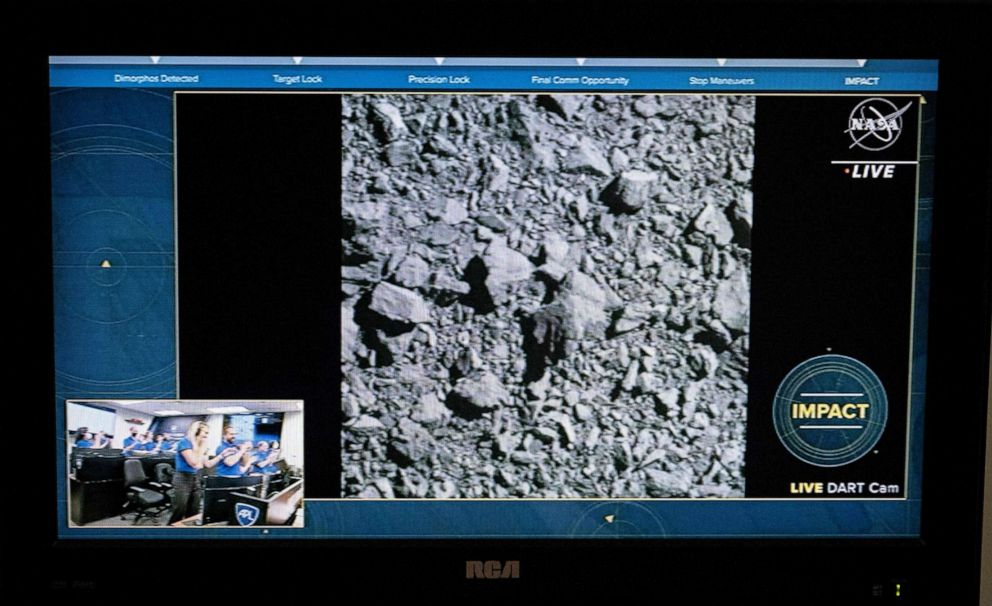
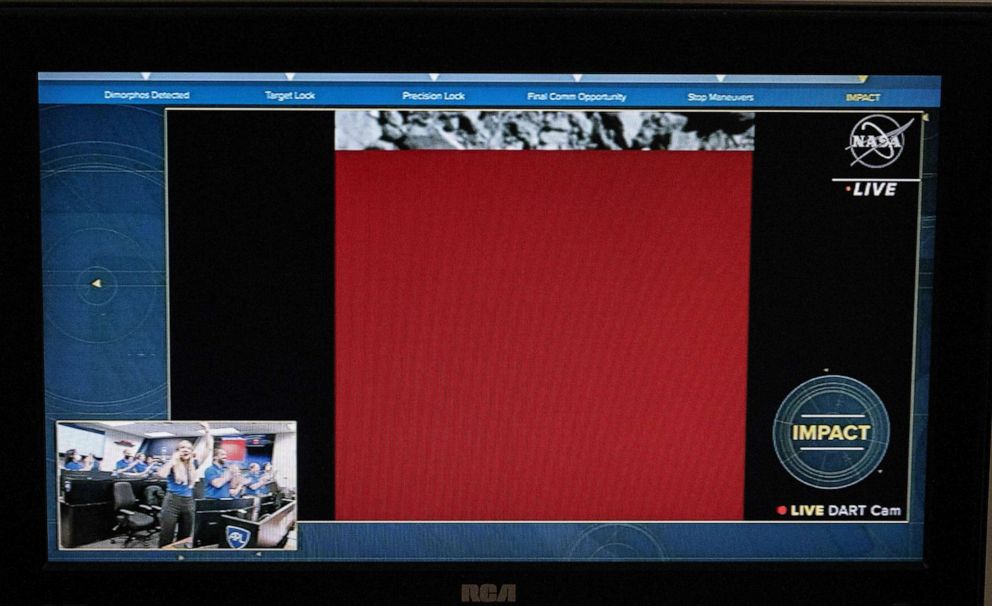
Dimorphos: Nasa flies spacecraft into asteroid in direct hit
The American space agency's Dart probe has smashed into an asteroid, destroying itself in the process.
The collision was intentional and designed to test whether space rocks that might threaten Earth could be nudged safely out of the way.
Dart's camera returned an image per second, right up to the moment of impact with the target - a 160m-wide object called Dimorphos.
What had been a steady image stream cut out as the probe was obliterated.
Controllers, based at the Johns Hopkins University Applied Physics Laboratory (JHU-APL), erupted with joy as Dimorphos filled the field of view on Dart's camera just before then going blank. Initial calculations suggest the impact was a mere 17m off the exact centre of Dimorphos.
It will be some weeks before scientists on the Nasa-led mission know for sure whether their experiment has worked, but Dr Lori Glaze, the director of planetary science at the space agency, was convinced something remarkable had been achieved.
"We're embarking on a new era of humankind, an era in which we potentially have the capability to protect ourselves from something like a dangerous hazardous asteroid impact. What an amazing thing; we've never had that capability before," she told reporters.
And Dr Elena Adams, a JHU-APL mission systems engineer, said "earthlings should sleep better" knowing they had a planetary defence solution.
Researchers will determine success, or otherwise, by studying the changes to the orbit of Dimorphos around another asteroid known as Didymos.
Telescopes on Earth will make precise measurements of the two-rock, or binary, system.
Before the collision, Dimorphos took roughly 11 hours and 55 minutes to circle its 780m-wide partner.
This ought to reduce by a few minutes following the crash.
Certainly, on the evidence of the pictures coming back from 11 million km from Earth, everything appeared to go exactly to plan.
The Dart probe, moving at the relative velocity of 22,000km/h, had to first distinguish the smaller rock from the larger one. Onboard navigation software then adjusted the closing trajectory with thruster firings to ensure a head-on collision.
Scientists were fascinated to see - albeit briefly - the different shapes of the two asteroids.
Didymos, as expected, had a diamond shape. There were boulders on its surface but also some smooth areas.
Dr Carolyn Ernst, the instrument scientist on Dart's camera system, was extremely excited to see Dimorphos.
"It looks adorable; it's this little moon; it's so cute," she said.
"It looks in a lot of ways like some of the other small asteroids we've seen, and they are also covered in boulders. So we suspect it is likely to be a rubble pile, kind of loosely consolidated."
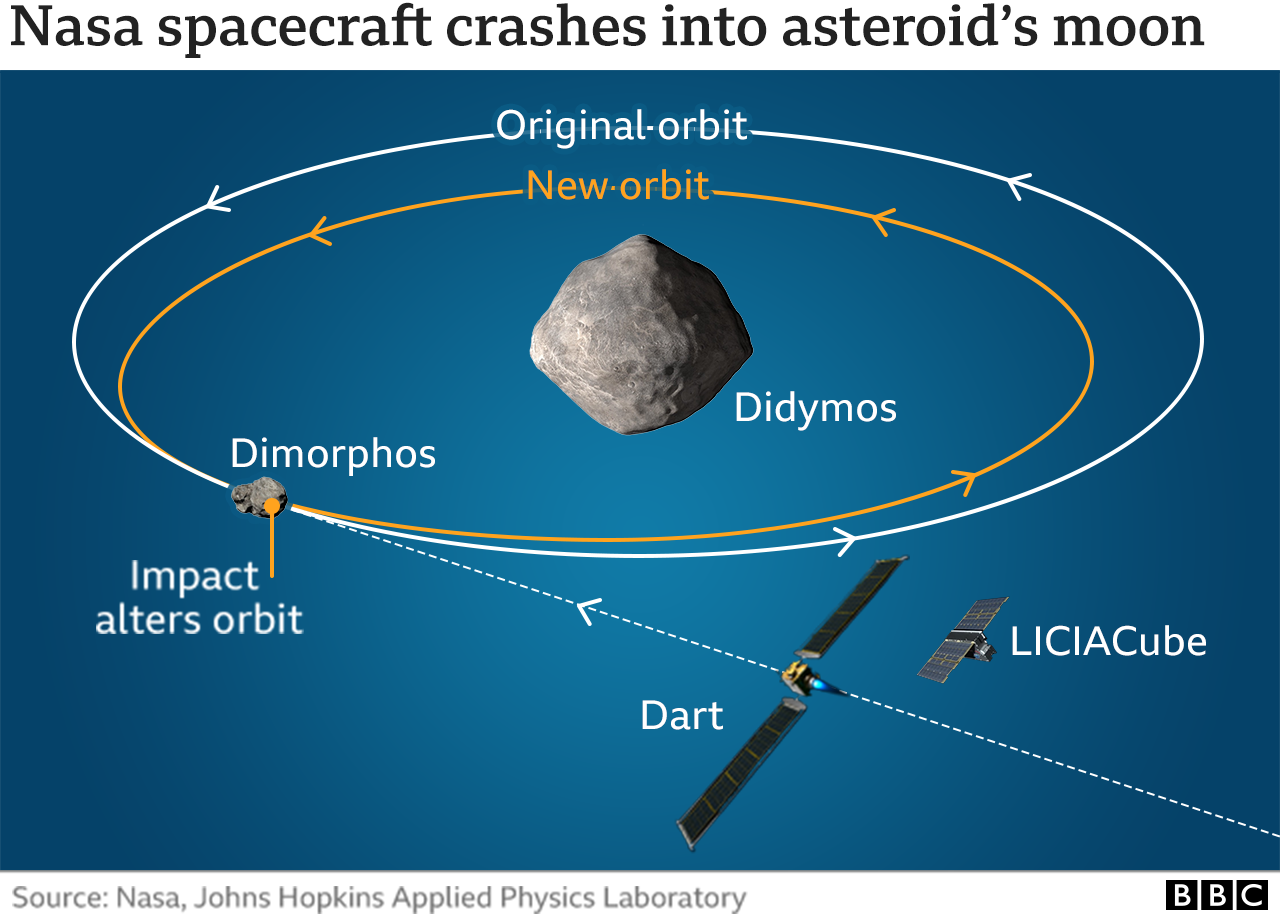
Dart is an acronym for Double Asteroid Redirection Test.
It was designed to do "exactly what is says on the tin", JHU-APL mission lead Dr Andy Rivkin told BBC News.
"This technique, called the 'kinetic impactor technique' could be used if there were to be an asteroid that was incoming at some point in the future. It's a very simple idea: you ram the spacecraft into the object you're worried about, and you use the mass and the speed of your spacecraft to slightly change the orbit of that object enough so that it would miss the Earth instead of hitting the Earth."
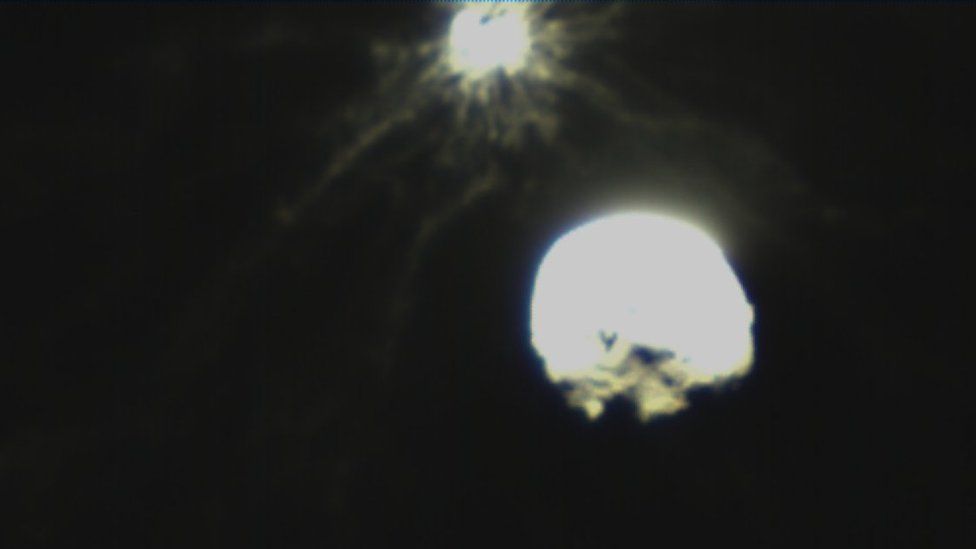
Dimorphos and Didymos were carefully chosen. Neither was on a path to intersect with Earth before the demonstration, and a small alteration in their orbital relationship will not have increased the risk.
But there are rocks out there that could potentially pose a danger to us.
Watch: The University of Hawaii's Atlas telescope saw the crash
Although sky surveys have identified more than 95% of the monster asteroids that could initiate a global extinction were they to collide with Earth (they won't; their paths have been computed and they won't come near our planet), this still leaves many so-far undetected smaller objects that could create havoc, if only on the regional or city scale.
An object of Dimorphos's scale would dig out a crater perhaps 1km across and a couple of hundred metres deep. The damage in the vicinity of the impact would be intense. Hence the desire to see if an asteroid can be nudged into going slightly slower or faster. The change in velocity wouldn't have to be great, especially if done many years in advance of the expected intersection with Earth.
"An analogy is if you're wearing a wristwatch and you damage it, and it starts running fast by a little bit," explained Dart mission scientist Dr Nancy Chabot, also from JHU-APL. "You might not notice the error in the first day or two, but after a few weeks you will begin to notice that the watch is just not keeping correct time anymore. It's running fast; it's ahead of where it should be."
Dart's image stream may have ended abruptly at impact, but there was a small Italian cubesat following three minutes behind. It was snapping away at the safe distance of 50km.
The LiciaCube's data will be beamed back to Earth over the next few days.
But even in the first picture returns it was evident that the cubesat caught sight of the plume of debris dug out by Dart.
Four years from now, the European Space Agency (Esa) will have three spacecraft - collectively known as the Hera mission - at Didymos and Dimorphos to make follow-up studies.
Quelle: BBC
+++
Bullseye! NASA’s DART Mission Impacts Asteroid Target in World First

DART team members in the mission operations center at Johns Hopkins APL celebrate after confirming DART’s successful impact into the asteroid Dimorphos on Sept. 26.
Credit: NASA/Johns Hopkins APL/Ed Whitman

DART team members in the mission operations center at Johns Hopkins APL excitedly take a closer look at the images the spacecraft’s onboard camera DRACO returned of the asteroid just seconds before impact.
Credit: NASA/Johns Hopkins APL/Ed Whitman
After 10 months flying in space, NASA’s Double Asteroid Redirection Test (DART), the world’s first planetary defense technology demonstration, successfully impacted its asteroid target on Monday — the agency’s first attempt to move an asteroid in space.
Mission control at the Johns Hopkins Applied Physics Laboratory (APL) in Laurel, Maryland, announced the successful impact at 7:14 p.m. EDT.
As a part of NASA’s overall planetary defense strategy, DART’s impact with the asteroid Dimorphos demonstrates a viable mitigation technique for protecting the planet from an Earth-bound asteroid or comet, if one were discovered.
“At its core, DART represents an unprecedented success for planetary defense, but it is also a mission of unity with a real benefit for all humanity,” said NASA Administrator Bill Nelson. “As NASA studies the cosmos and our home planet, we’re also working to protect that home, and this international collaboration turned science fiction into science fact, demonstrating one way to protect Earth.”
“This first-of-its-kind mission required incredible preparation and precision, and the team exceeded expectations on all counts,” said APL Director Ralph Semmel. “Beyond the truly exciting success of the technology demonstration, capabilities based on DART could one day be used to change the course of an asteroid to protect our planet and preserve life on Earth as we know it.”
DART targeted the asteroid moonlet Dimorphos, a small body just 530 feet (160 meters) in diameter. It orbits a larger, 2,560-foot (780-meter) asteroid called Didymos. Neither asteroid poses a threat to Earth.
The mission’s one-way trip confirmed NASA can successfully navigate a spacecraft to intentionally collide with an asteroid to deflect it, a technique known as kinetic impact.
The investigation team will now observe Dimorphos using ground-based telescopes to confirm that DART’s impact altered the asteroid’s orbit around Didymos. Researchers expect the impact to shorten Dimorphos’ orbit by about 1%, or roughly 10 minutes; precisely measuring how much the asteroid was deflected is one of the primary purposes of the full-scale test.
“Planetary Defense is a globally unifying effort that affects everyone living on Earth,” said Thomas Zurbuchen, associate administrator for the Science Mission Directorate at NASA Headquarters in Washington. “Now we know we can aim a spacecraft with the precision needed to impact even a small body in space. Just a small change in its speed is all we need to make a significant difference in the path an asteroid travels.”
The spacecraft’s sole instrument, the Didymos Reconnaissance and Asteroid Camera for Optical navigation (DRACO), together with a sophisticated guidance, navigation and control system that works in tandem with Small-body Maneuvering Autonomous Real Time Navigation (SMART Nav) algorithms, enabled DART to identify and distinguish between the two asteroids, targeting the smaller body.
These systems guided the 1,260-pound (570-kilogram) box-shaped spacecraft through the final 56,000 miles (90,000 kilometers) of space into Dimorphos, intentionally crashing into it at roughly 14,000 miles (22,530 kilometers) per hour to slightly slow the asteroid’s orbital speed. DRACO’s final images, obtained by the spacecraft seconds before impact, revealed the surface of Dimorphos in close-up detail.
“What a remarkable day for humanity,” said APL Space Exploration Sector Head Bobby Braun. “The team nailed it — and I couldn’t be more proud of their efforts. Data from this test will inform future planetary defense efforts. Today is a milestone in demonstrating just how far our nation’s space program has come, and how important it is to all of us here on Earth.”
Fifteen days before impact, DART’s CubeSat companion Light Italian CubeSat for Imaging of Asteroids (LICIACube), provided by the Italian Space Agency, deployed from the spacecraft to capture images of DART’s impact and of the asteroid’s resulting cloud of ejected matter. In tandem with the images returned by DRACO, LICIACube’s images are intended to provide a view of the collision’s effects to help researchers better characterize the effectiveness of kinetic impact in deflecting an asteroid. Because LICIACube doesn’t carry a large antenna, images will be downlinked to Earth one by one in the coming weeks.
“DART’s success provides a significant addition to the essential toolbox we must have to protect Earth from a devastating impact by an asteroid,” said Lindley Johnson, NASA’s planetary defense officer. “This demonstrates we are no longer powerless to prevent this type of natural disaster. Coupled with enhanced capabilities to accelerate finding the remaining hazardous asteroid population by our next Planetary Defense mission, the NEO Surveyor, a DART successor could provide what we need to save the day.”
With the asteroid pair within 7 million miles (11 million kilometers) of Earth, a global team is using dozens of telescopes stationed around the world and in space to observe the asteroid system. Over the coming weeks, they will characterize the ejecta produced and precisely measure Dimorphos’ orbital change to determine how effectively DART deflected the asteroid. The results will help validate and improve scientific computer models critical to predicting the effectiveness of this technique as a reliable method for asteroid deflection.
Roughly four years from now, the European Space Agency’s Hera project will conduct detailed surveys of both Dimorphos and Didymos, with a particular focus on the crater left by DART’s collision and a precise measurement of Dimorphos’ mass.
Johns Hopkins APL manages the DART mission for NASA’s Planetary Defense Coordination Office as a project of the agency’s Planetary Missions Program Office.
For more information about DART, visit https://www.nasa.gov/dartmission or https://dart.jhuapl.edu/.
Quelle: NASA
----
Update: 29.09.2022
.
Photos show plumes from impact of NASA's DART collision with asteroid

Impact confirmed.
The dramatic moment when a NASA spacecraft intentionally flew head-on into an asteroid was captured by a tiny, Italian-built satellite that was designed to survey the aftermath of the cosmic collision.
Photos of NASA's DART probe slamming into a small and harmless asteroid known as Dimorphos were released Tuesday by L'Agenzia Spaziale Italiana, the Italian Space Agency. The images show Dimorphos and the larger, brighter asteroid that it orbits right before and immediately after the impact.
The intentional crash, which occurred Monday, was the world's first test of a planetary defense strategy that involves "nudging" an asteroid to permanently alter its trajectory. Dimorphos is located about 6.8 million miles from Earth and does not pose any threat to the planet.

After impact, LICIACube flew within 35 miles of the asteroid Dimorphos to survey the collision's aftermath.ASI / NASA
The Italian Space Agency's cubesat, dubbed LICIACube, was released as the DART spacecraft neared its asteroid target. The tiny companion satellite captured spectacular images of the change in Dimorphos' brightness as the DART probe smacked into the space rock's surface, creating a plume of ejected material.
Argotec, the Turin-based engineering firm that built LICIACube, tweeted Tuesday: "This is exactly where the #NASA #DartMission ended. An incredible emotion, the beginning of new discoveries."
A few minutes after the cosmic spectacle, LICIACube flew within 35 miles of Dimorphos, snapping photos of the outcome. The first photos were beamed back to Earth at 4:23 a.m. local time in Italy, according to the Italian Space Agency.
It will also take some time to process and study the imagery from LICIACube and the DART spacecraft's own onboard camera, which broadcast live views as the probe approached Dimorphos, right up until it slammed into the asteroid's boulder-filled surface.
"Now weeks and months of hard work are now starting for scientists and technicians involved in this mission, so stay tuned because we will have a lot to tell!" the LICIACube team tweeted Tuesday.
The tiny cubesat was deployed by the DART probe on Sept. 11. In the weeks leading up to the main event, LICIACube (short for Light Italian Cubesat for Imaging Asteroids) captured test photos of Earth and the Pleiades star cluster.
The cubesat is carrying two cameras: one with a wider field of view nicknamed LUKE, and a black-and-white camera dubbed LEIA that will capture high-resolution images.
The DART mission, short for Double Asteroid Redirection Test, was designed to test humanity’s ability to protect Earth from a potentially catastrophic collision with a space rock.
Quelle: NBC
+++
Fresh images reveal fireworks when NASA spacecraft ploughed into asteroid


